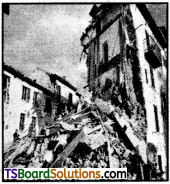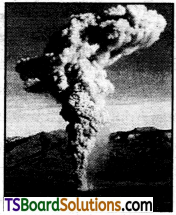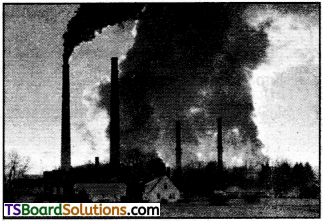Telangana TSBIE TS Inter 1st Year Environmental Education Study Material 8th Lesson Natural and Manmade Disasters Textbook Questions and Answers.
TS Inter 1st Year Environmental Education Study Material 8th Lesson Natural and Manmade Disasters
Essay Questions
Question 1.
Define Disasters and what are its types? Explain Natural Disasters.
Answer:
A disaster is a sudden, calamitous event that seriously disrupts the functioning of a community or society and causes human, material, and economic or environmental losses that exceed the community’s or society’s ability to cope using its own resources. Disasters can broadly be classified as a) natural disasters b) man-made disasters.
Natural disasters are a major adverse event resulting from natural processes of the Earth. Some examples of natural disasters are : floods, forest fires, hurricanes, tornadoes, volcanic eruptions and earthquakes.
Man-made disasters involve an element of human intent, negligence, or error; or involve a failure of a man-made system. Stampedes, road and railway accidents, plane crashes and fire accidents are examples of man-made disasters which result in human suffering and loss of lives. The damage to the environment is often temporary and negligible. Sometimes, however, the impact of man-made disasters on the environment is colossal and long lasting, There may be a large scale destruction of lives and property. Examples are nuclear disasters, war, industrial accidents and oil spills in the ocean.
Given below are tables containing informanon about various natural and man made disasters and the damage that ensures :
I. Natural Disasters :
| Type | Desription | Damage |
| Earthquake | An earthquake is a shaking of the ground caused by the sudden breaking and movement of tectonic plates of the Earth’s rocky outermost crust. | The shifting masses send out shock waves that may be powerful enough to alter the surface of the Earth, thrusting up cliffs and opening great cracks in the ground. Earthquakes cause loss of lives and also great damage, like collapse of buildings, broken power and gas lines, landslides snow avalanches, tsunamis. |
Volcanic eruptions |
A volcanic eruption occurs when hot materials are thrown out of a volcanoes. Eruptions can come from side branches or from the top of the volcano. Kilauea, in Hawaii, is considered one of the worlds most frequently active volcanoes. It erupted in May 2018. | Hot lava can travel very far and burn, bury or damage buildings and trees in its path. Ash may cause roofs to collapse under its weight. Even small quantities can harm humans if inhaled.
The main danger from a volcano is the immense cloud of ash which has a disastrous global effect on climate and temperature for many areas. |
| Cyclone | A cyclone refers to any low pressure area with winds spiraling inwards. |
The main effects of tropical cyclones include heavy rain, strong wind and large storm surges at landfall.
Sea water with combined force rushes inlands and inundates the low lying areas. |
| Flood | A flood is an overflow of an expanse of water that submerges land. | The primary effects of flooding include loss of life, damage to buildings, bridges, sewerage systems, roadways and canals. Floods also frequently damage power transmission. |
| Drought | A drought is a period of below-average precipitation in a given region, resulting in prolonged shortages in the water supply, whether atmospheric, surface water or ground water. | Shortage of water can adversely affect both residential areas and industrial areas.
The formation of dust bowls indicates severe erosion of land. Diminished crops and severe scarcity of food may ensue. Droughts have a devastating impact on livestock. Damage to wildlife takes place. |
| Tsunami | A tsunami is a series of water waves caused by the displacement of a large volume of body of water, gen eraliy an ocean or a large lake. Earthquakes, volcanic eruptions and other under water explosions, landslides, glacier calvings (breaking), meteorite impacts and other disturbances above or below water all have the potential to generate a tsunami. | The force of a tsunami causes massive damage and loss of life. The push of saltwater into freshwater sources nearby can disrupt farming, Floodling can also carry sew age and toxic substances into the environment, posing a health risk. |
| Landslide | A landslide is defined as the movement of a mass of rock, debris, or earth down a slope. Landslides are a type of “mass wasting,” which denotes any down-slope movement of soil and rock under the direct influence of gravity. | Landslides cause property damage, injury and death and adversely affect a variety of resources. For example, water supplies, fisheries, sewage disposal systems, forests, dams and roadways can be affected for years. |
| Epidemic | An epidemic occurs when a disease strikes a large number of people at one time. It spreads at a rapid rate. E.g.: SARS virus, swine flu, ebola, nipah virus. Many diseases are spread after natural disasters like tsunami, floods etc. | Loss of lives, damage to the economy, adverse effect on tourism, breakdown of public health infrastructure. A pandemic is the sudden outbreak of a disease that affects a whole region, a continent or the world and causes a high degree of mortality. |
II. Man-Made Disasters :
| Type | Description |
| Nuclear disaster | A nuclear accident involves leakage of radioactivity. This can happen in nuclear reactors due to an explosion. An example is the Fukushima Daiichi, Japan, nuclear disaster in 2011. The reactors were damaged by tsunami waves generated by a severe earthquake. |
| Biological arfare | Biological weapons involve the use of toxins or infectious agents that are biological in origin, such as bacteria, viruses, or fungi. These agents are used to spread deadly diseases like smallpox and anthrax and can incapacitate or kill humans, animals or plants as part of a war effort. They are easy to manufacture and transport. Though biological and chemical weapons were banned world wide after World War I, it is believed that some nations continue to develop them secretly. |
| Chemical disaster | Disasters that are caused by the accidental or unintentional release of harzardous substances which can harm human health or the environment. The irresponsible handling of powerful chemicals can cause widespread devastation. |
| Fire accident | Accidents that are caused due to fire are quite common. Fire results in heavy damage both in terms of life and property. Loss of life is high in a crowded building. The Great Fire of London in 1666 left hundreds of thousands of people homeless and left only a fifth of the city intact. |
| Travel accident | Travel accidents are quite common. An accident which involves a number of people becomes a disaster. Examples of these disasters are air crashes, train or vehicles collisions and capsizing of boats. |
| Terrorism and War | War ravages countries and decimates human populations. It may take several decades for a country to recoup from the effects of war. The damage to the environment may be irreversible. Terrorists use violence and strike without warning. They use bombs, guns and other weapons to kill people. The hijacking and crashing of planes into the twin towers of the World Trade Centre, New York, in September 2001. is a dark chapter in the history of terrorism. |
![]()
Question 2.
Write an essay on Disaster Management.
Answer:
Disaster management is defined as the organization and management of resources and responsibilities for dealing with all. humanitarian aspects of emergencies, in particular preparedness, response and recovery in order to lessen the impact of disasters. It refers not only to steps taken after a disaster occurs, such as providing shelter and food to those affected by an earthquake or fire, and rebuilding property that has been destroyed, but also includes preventive measures that are taken by the government as well as citizens to avert impending loss of life and property when a disaster is expected to take place.
For example, in 2014 when Hudhud, a cyclone of intense severity, was expected to strike the eastern coast of India, fishermen were warned not to venture into the sea, citizens were advised to stay indoors and hourly updates regarding the movements of the cyclone were broadcast. Thousands of people living in low lying areas were evacuated and given shelter in safe places. Though the damage to property in and around Visakhapatnam was colossal, the loss of lives was greatly minimized because of good disaster management.
Given below are some of the measures that can be taken by people to minimize the impact of natural disasters :
Cyclone :
- Keep track of the weather warnings that are being broadcast on T.V or the radio. This will help you prepare for an emergency evacuation.
- Prepare an emergency kit consisting of dry food, water, warm clothes etc.
- Remain indoors. Stay in the strongest part of the building.
- Board up the windows and lock the doors.
- At the onset of the cyclone, disconnect all electrical appliances and turn off the gas. Do not venture outdoors till it is declared safe to do so.
Heat Weave :
- Avoid going out in the Sun, especially between 12.00 noon and 3.00 p.m.
- Drink sufficient water and as often as possible, even if not thirsty.
- Wear light-weight, light-coloured, loose, and porous cotton clothes. Use protective goggles, umbrella/hat, shoes or chappals while going out in the Sun.
- Avoid alcohol, tea, coffee and carbonated soft drinks as these dehydrate the body.
- Avoid high-protein food and do not eat stale food.
- Use ORS (oral rehydration solution), homemade drinks like lassi, torani (rice water), lemon water and buttermilk which help to re-hydrate the body.
- Keep animals in the shade and give them plenty of water to drink.
Sun Stroke :
- Make the affected person lie in a cool place or in the shade. Wipe her/him with a wet cloth/wash the body frequently. Pour water of normal temperature on the head. It is important to bring down the body temperature.

- Give the person ORS to drink or lemon sarbat/torani to rehydrate the body.
- Take the person immediately to the nearest health centre. The patient needs immediate hospitalisation as heat strokes can be fatal.
Flood :
If a flood is likely to hit your area, one should :
- Listen to the radio or television for information.
- Be aware that flash flooding can occur. If there is any possibility of a flash flood, move immediately to higher ground. Do not wait for instructions to move.

- Be aware of streams, drainage channels, canyons, and other areas known to flood suddenly. Flash floods can occur in these areas with or without typical warnings such as rain clouds or heavy rain.
- Turn off utilities at the main switches or valves if instructed to do so. Disconnect electrical appliances. Do not touch electrical equipment if you are wet or standing in water.
Earthquake :

Have a disaster emergency kit ready which contains: Battery operated torch, battery operated radio, first aid kit, emergency food (dry items) and water (packed and sealed), candles and matches in a waterproof container, chlorine tablets, essential medicines, cash and credit cards, thick ropes and sturdy shoes.
If-indoors :
- Drop to the ground; take cover by getting under a sturdy table or other piece of furniture; hold on until the shaking stops. If there is no table or desk near you, cover your face and head with your arms and crouch in an inside corner of the building.
- Stay away from glass windows, outside doors and walls, and anything that could fall, (such as lighting fixtures or furniture).
- Use a doorway for shelter only if it is in close proximity to you and if you know it is a strongly supported, load bearing doorway.
- Stay inside until the shaking stops and it is safe to go outside. Research has shown that most injuries occur when people inside buildings attempt to move to a different location inside the building or try to leave.
- Be aware that the electricity or fire alarms may go out.
If-outdoors :
- Do not move from where you are. However, keep away from buildings, trees, streetlights and utility wires.
- If you are in open space, stay there until the shaking stops. The greatest danger exists directly outside buildings, at exits and alongside exterior walls. Most earthquake-related casualties result from collapsing walls, flying glass and falling objects.
Given below are some measures that can be taken to minimize the impact of Man Made Disasters :
Nuclear Disaster/Exposure to Radiation Disaster :
- It is imperative for the management and the government to conduct onsite (within the nuclear plant, where workers are affected) and offsite (surrounding areas where residents are affected) emergency response planning and training, besides conducting mock drills.
- In the event of a nuclear disaster, people within a 10 mile ERZ (Emergency Radiation Zone) are evacuated to a safe place so that their risk of being exposed to radiation is minimized.

- Residents may be given potassium iodide tablets by the government to reduce or prevent the effects radiation.
- People should not drink water from open wells/ponds; they should avoid crops and vegetables that are grows in a 50 mile ERZ as there are high chances of radioactive contamination of food and water supplies.
- People should follow the instructions of the district or civil defence authorities and not panic.
Chemical Disaster :
- Do not panic, evacuate the premises calmly and quickly move in a direction that is perpendicular to the wind direction through the designated escape route.
- Keep a wet handkerchief or piece of cloth/sari on the face during evacuation.
- Keep the sick, elderly, weak and handicapped inside the house and close all the doors and windows tightly.

- Do not consume uncovered food and water left open to the air. Drink only from covered bottles.
- Change into fresh clothing after reaching a safe place/shelter and wash hands properly.
- Inform Fire & Emergency services, Police and Medical services from the safe location by calling 101, 100 and 108 respectively.
- Provide correct and accurate information to government officials.
- Inform/Caution others about the occurrence of the event at public gathering places (like schools, shopping centres, theatres etc.).
- Do not pay attention to rumours and do not spread rumours.
Fire disaster management :
- During a fire do not panic.
- Alert the firemen (fire service), ambulance services and nearby police stations.
- Use fire extinguishers.
- Deaths due to fire accidents mostly occur due to inhalation of smoke and asphyxiation rather than burning. Cover your head with a towel soaked in water and breathe through it.
- Evacuation of the trapped people should be undertaken in a systematic manner.
- People whose clothes have caught fire should be covered in blankets or coats and rolled on the ground.
- Elevators should not be used when there is a fire.
![]()
Question 3.
Discuss some Global Environmental Disasters.
Answer:
London’s Killer Fog Also called the Great Smog of London, it was a severe air pollution event that affected London for several days in December 1952. The city was covered with a thick, black blanket of fog and smoke, containing nitrogen oxide, soot, and sulfur dioxide. Visibility was drastically reduced as the smog entered indoors too. It is estimated that nearly 12,000 people were killed in this disaster.
The Nuclear Power Plant Explosion in Chernobyl, Ukraine :
In April 26, 1986, a reactor shutdown was experienced at the Chernobyl Nuclear Facility. The horrific fire and explosion that ensued claimed the lives of 50 personnel instantly and emitted more than 400 times the radiation released during the Hiroshima atom bomb. More than 4000 cancer deaths have been linked with the extensive spread of radioactive substances. Radiation levels at the site are still high.
Union Carbide Cyanide Gas Leak, Bhopal, India :
On December 3, 1984, a Union Carbide India Limited pesticide plant in Bhopal, Madhya Pradesh, India accidentally released a deadly chemical fog, which killed more than 5,000 people. They were victims of fatal poisoning by methyl isocyanate. More than 50,000 people underwent treatment due to exposure to the gas. It is believed that the gas leak has claimed an additional 20,000 lives since. It is regarded as the worst industrial chemical disaster in history.
Minamata Disease Disaster :
Industrial waste water containing methyl mercury was released by Chisso Corporation into Minamata Bay and the Shiranui Sea in Japan from 1932 to 1968. The highly toxic chemical accumulated in shell fish and other fish. The local people who consumed the fish fell victim to mercury poisoning. The cause of the disease was identified in 1956. About 2000 people died as a result of ‘Minamata disease’ and another ten thousand people were affected seriously.
British petroleum oil spill, Gulf of Mexico : On April 20, 2010, there was an explosion and sinking of the deep water horizon oil rig in the Gulf of Mexico. The explosion was regarded as the most prominent accidental marine oil spill in the petroleum industry history. Eleven employees died. The explosion released about 60 million barrels of mixed grade oil from the disconnected well over a period of four months. Over 34,000 birds (including egrets and blue heron) hundreds of sea turtles, about 72 dolphins and other marine vertebrates and invertebrates were poisoned and suffocated in the oil.
Gulf of Mexico dead zone : This is one of the ill-famed aquatic regions that arose as a consequence of human activity. It is considered the largest “dead zone” region in the United States. Hundreds of fish are often found floating dead in the Gulf of Mexico Dead Zone. The cause for the “dead zone” is the relentless dumping of phosphorus and nitrogen nutrients in the area. The nutrients come from the Mississippi River, which is the drainage area for nearly half the nitrogen and phosphorus waste of continental America. Aquatic species including plants, fish and cannot survive in the area.
E-waste In Guiyu, China :
Guiyu, China is considered the area which is the biggest electronic waste site on the planet. Massive amounts of obsolete electronics are dumped in the area. It has resulted in high toxicity levels of heavy metals and chemicals in the region’s soils and water systems. Consequently, about 88% of the children in the province suffer from lead poisoning and there is a higher than normal rate of miscarriages. The province is labelled the world’s “electronic graveyard”.